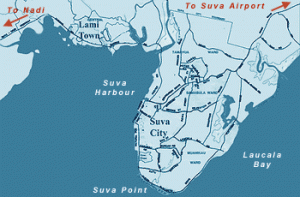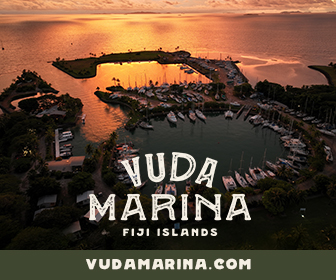Fiji: Checking in to Suva – Cruisers Report
Suva currently offers flexibility when clearing in, permitting boats that arrive at the weekend to remain at anchor with their “Q” flag flying and clear in on Monday to avoid the high overtime costs. As far as we know this is not possible in other check ports in Fiji. For Lautoka, Savusavu etc, overtime costs will be incurred.
Published 7 years ago, updated 6 years ago

- Map of Suva @www.fijiSuva.com
May 2018 – Yann and Helena, SV Alcyone
Yann and Helena arrived in Suva during the weekend. They were familiar with Fiji clearance procedures having previously arrived in Savu Savu and Lautoka. They knew about the steep weekend costs for checking in. Working through the Royal Suva Yacht Club they were able to wait with their Q flag flying until Monday. Here is their story.
We arrived on Saturday morning and asked the help of RSYC for all the process; (ch 16 then 17) who asked us if we prefer to wait for Monday or to be cleared immediately with overcharge…we chose the first solution; A nasty wreck (long, with a simple stake without light, and just above sea level) on the way to RSYC justifies a wait until daylight to arrive if you don’t have any waypoints.
On Monday, we have to be prepared not to be a priority…commercial vessels come first in SUVA except the Quarantine who came on board at 11h00. All the other officials (immigration, health and customs) arrived together at 15h30, “just after lunch”; they were all very nice and polite, just not in a hurry. The Biosecurity guy accepted nzd (65nz for 85f$). When they left the boat, it was too late to visit any administration, but not to get some cash and phone card downtown through the RSYC; Nice, helpful ladies again in this old RSYC. If you are not sure to leave Suva in less than 3 days, getting a temporary member card for 1 member of the family is the best (45 f$) as if not, dinghy dock is 10f$/day and showers 3f$/person.
On Tuesday, we had to visit 3 offices in this order which gave us an interesting vision of Suva. The ‘procedure’ takes less than an hour if you use the cheap taxis:
1) The quarantine (first floor of a decaying building in the heights of Suva) to pay 163,5 f$, (10min if you come with exact change).
2) The magnificent Itaukei affairs board to get our cruising permit; in a beautiful park with free and quick delivery of the permit (all places). Obviously, one of the best government administrations to work in Suva regarding the level of education of the staff including the impressive -in shape and education- guard (10min).
3) The rustic Customs office where you have to receive your local clearance after getting the cruising permit. Here again, nice people in a very difficult building to work in (20min inside including the punishment return walk along the fence from the entrance to the 1st-floor office).
As a summary here are the present costs to enter in Suva, Fiji dollars
– Quarantine (to pay downtown), 163,5
– Biosecurity (possible to pay on board in nzd), 85
– Immigration (onboard) 0
– Cruising permit to visit downtown 0
– Custom to visit downtown 0
– Yacht Club service to organise the boarding party, 60
– 4 Taxis (RSYC->Quarantine->Itaukei foreign->Customs->RSYC), 16
– Dinghy dock in RSYC, 10
TOTAL 334,5 if you don’t get the RSYC membership.
And if you arrive on Saturday, you can’t be sure to be cleared 100% before Tuesday…Welcome to Island Time!
Yann
August 2016 – By Tim Christensen
I am sure Fiji has some really nice places to visit, secluded harbours, white sand beaches, clear water and the likes. Suva is not one of those places.
We arrived a few hours before sunrise on Monday, August 15, 2016, and hove-to outside the harbour until daylight. The entrance through the reef is plenty wide, maybe a quarter mile, and marked with day beacons to port and a green buoy to starboard. The navigation aids are unlit with the exception of the neon blue range lights for the initial approach and transit through the cut. I use CM93 electronic charts that seemed to be right on the mark. Watching ferry traffic make the entrance predawn on AIS, they travelled right down my track line, further proving the chart. Never the less, even with high confidence in the accuracy of the chart, I decided it was prudent to wait for sunrise before entering. That being said, a nighttime arrival would not be particularly risky.
A little before 0700, I called Suva Port Control on VHF 16 and requested permission to enter the port, bound for the quarantine anchorage. In fluent English, the request was promptly granted with a warning about an outbound container ship.
There is a designated quarantine anchorage on the chart but it was in 20 meters of water. I actually anchored slightly northeast of the designated anchorage (L 18⁰ 07.33’ S, λ 178⁰ 25.50’ E) in 3 meters (under keel), just in front of the Royal Suva Yacht Club (RSY), and adjacent to a sunken but exposed hulk resting on the bottom. The bottom comes up very gradually to your chosen depth, although depths are somewhat shoaler than the chart indicates. The composition is soft mud and appears to be the product of silt accumulation. There were six or eight other cruisers on the hook in the vicinity, a half dozen ships in deeper water, and several groups of long-liners rafted together on single moorings.
We were securely anchored by 0800 with a chance to take in the sights. The water around us had an oil sheen glistening in the early morning sun. Looking at the shoreline, it is clearly a tired industrial neck of the woods. A shipyard with a floating drydock, a fish market with catcher processors jockeying for position, dilapidated warehouses and other industries crowding the waterfront. I wondered how much of the squalor was a result of the typhoon last year and how much was a result of unfettered capitalism run wild.
I called the RSY on VHF Ch#16 at 0800 to request the clearance officers be arranged and they graciously assisted the request. We were advised to stay on board and everyone would be brought to us. The Health inspector was the first to arrive at about noon. She did a cursory inspection of the boat, overlooking some onions and fresh ginger hanging in a hammock in plain sight. Didn’t ask about other fresh produce or meat products or even look in the fridge. Only asked to see the canned goods locker, but didn’t take exception with any of the cans. She asked our last port and said that will be F$163.50, please. She wrote down the address of her office and advised that once we were cleared in, to come to her office and make the payment. She did not spray Margarita with insecticide as warned in my guide. Before leaving, she asked us to strike the “Q” flag.
By 1530, I was wondering if the remainder of the entourage were going to show up before the close of business. I called RSY again to see if they had heard anything. The receptionist offered to call and check on the progress. A little after 1600, a much less friendly group arrived. One Customs officer, one Immigration, and a Bio-security officer boarded Margarita while the launch skipper remained in the boat.
I offered everyone a seat in the cockpit thinking the cramped environment would hasten their visit. The Bio-Security started first with lots of questions, most of which were already addressed in the nine-page pre-arrival documentation. He asked me if I had food aboard. I replied that in fact I did but his eyes were waiting for an elaboration. I asked him if he seriously expected me to list all of my food stores and he declined the offer but asked if I had rice, (yes), do you have canned goods, (yes). Likewise, he said thank you, that’ll be F$83.00 payable in my office tomorrow.
Next was Immigration. I filled out the usual arrival cards for the three of us and some other forms of little significance. I checked yes to several of the questions on the back side of the arrival cards such as fresh meat and produce, but he seemed to take little if any notice. The officer asked if I had a stapler. When I apologised that I didn’t, he explained that I would have to come to his office to get the final clearance paperwork because it absolutely had to be stapled.
Lastly was the Customs officer, a particularly unfriendly woman that appeared to be convinced that I was in the wrong before I even arrived. Neither of us knew the specifics of what I had done but she knew I did it all right. She asked me if I had submitted the pre-arrival documentation 48 hours prior to arrival as required. I told her that not only had I sent it to Customs, but to Bio-Security as well, and I had even taken the liberty of printing her very own copy. I mentioned that in fact, I had also received a reply from her office that the document was accepted, should there be any question. She looked at me in disbelief, but I am sure that was cover for her failure to check herself beforehand. She proceeded to load me up with a bunch of forms to fill out, I guess she got the last laugh on that one. One of the forms asked the value of Margarita, I wrote F$20k. She questioned, “No, in Fijian dollars”. I said yes, 20k in Fijian dollars. She clearly wasn’t happy with that answer, but I have been down this valuation road with Customs before, much to my demise. Prove me wrong or make an offer to buy her… With that, they gathered up all their paperwork and shuffled back aboard the waiting launch. None of this group ever went below decks.
Brian, Nok, and I launched and assembled the dinghy for some shore leave. Motoring into the Royal Suva Yacht Club, the aroma of raw sewage in the water was overwhelming. The marina itself looked mostly full of day boats and small cruisers that looked like they arrived in the ’70s but haven’t moved much since then. There are a potable water hose and a trash can available close to the floating dingy dock. The Marina has some haulout facilities for small to mid-sized planing hulls, a fuel dock, kids playground, a bar with a pool table and a restaurant. I asked in the bar if they had WiFi and the bartender said they didn’t. I then asked if she knew where I might find WiFi and she didn’t know that either. A very small (think teacup) local draft and a bottled apple juice came to F$6.80.
You have to be a member of the Yacht Club to use the dinghy dock and I suspect there are few options for alternative landing spots. The Club charges F$60.00 for the transport of the officialdom to your boat and another F$25.00 per person per month for access to the club. Should you decide to pick up one of the few med-mooring berths within the marina, they want F$50.00/night or F$800.00 per month. Once a member, you have the privilege of paying F$5.00/kg for laundry services and access to their toilets and showers with a F$20 key deposit.
We walked out to the main road to find an ATM. Walking past the 20 foot high, spiral razor wire-topped walls of the Fijian penal colony across the street, (Circa 1912) it was only about a ten-minute walk to an ATM. First impressions; this is clearly not the tourist district and maybe not somewhere you want to be caught after dark. A dusty industrial neighbourhood along a bustling motorway. It must have been around 1730 or 1800 and the mostly Indian-looking workers were streaming out of the warehouses to wait for crowded-to-capacity city buses for the journey home after a days work. We purchased a F$9.00 slice of raspberry cheesecake for takeaway from the yacht club restaurant on our walk home and made our way back to Margarita.
Tim Christensen
S/V Margarita
August 2013 – By Suzie Ohagan
The process for checking in to Suva is straightforward, as the Royal Suva Yacht Club organises everything for you. Their fees have recently changed; it now costs FJ60 for their boat to bring officials out to you (no other option possible) and usage of the RSYC dinghy dock is FJ 15 per person. That latter fee allows you to use their garbage services, restaurant, bar etc. You also pay a $1 RSYC membership fee per person.
Checking in is a painless process, except that the officials seem to arrive en mass in the early afternoon. So unless you arrive before about 1530 you are likely to have to wait until the following day (afternoon) to be processed. As it was raining the day we arrived, the only official who came to our yacht in the RSYC boat was from Health. We were then politely asked to come ourselves to the clubhouse where all the other officials were processing yachts (in the dry!).
Some confusion has arisen about where to obtain your Cruising Permit (this can only be obtained once you have been officially checked in). The permit is free but you must make your own way to the iTaukei Affairs Board which is in the Great Council of Chiefs Complex in the Government complex at 87, Queen Elizabeth Drive, Suva. This road is an extension of Victoria Parade (shown on city centre maps). It is about 3 km walk to the government buildings and you need to enter the huge complex at the first entrance which will take you along the side of the building. Then take the first door on your right and someone will direct you. If you ask for the Great Council of Chiefs building, taxi drivers and bus drivers will know what you want. Several people have been given wrong directions about the iTaukei Affairs Board location and as a result, have walked back to Suva centre empty handed and with sore feet.
Suzie Ohagan
Related content







